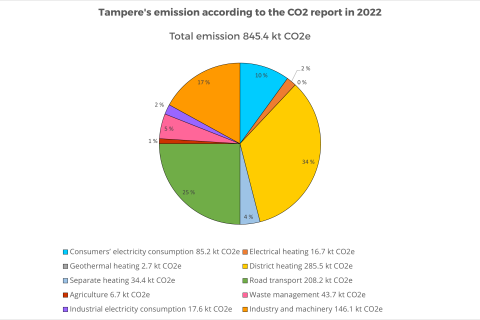Climate emissions in Tampere

Tampere’s greenhouse gas emissions have been monitored since 2010 with the help of the CO2 report. The CO2 report is a municipal emission calculation and reporting service that covers all of Finland and is produced by Sitowise Oy. Approximately 90 municipalities have subscribed to the service.
In 2022, Tampere’s greenhouse gas emissions totalled 845.4 kilotons of carbon dioxide equivalent (abbr. CO2e). CO2e, or CO2 equivalent, is a unit, in which the warming effect of different greenhouse gases has been converted into a corresponding amount of CO2.

Compared to 1990, Tampere’s total emissions have decreased by 35 per cent and per capita emissions by 55 per cent. The main sources of emissions are building heating and transport. In 2021, Tampere’s emissions per capita, excluding industry, amounted to 2.7 tonnes CO2e, compared to 2.1 to 14.2 tonnes CO2e in all municipalities included in the CO2 report.
When industrial emissions were included in the review, the combined emissions stayed at the same level, and emissions per capita decreased by just over 2 per cent from 2021 to 2022. When industry was not considered, the total emissions decreased by 5 per cent from 2021 to 2022.
The calculations include electricity consumption by consumers and industry, electrical heating, geothermal heating, district heating, separate heating, industry and machinery, road transport, agriculture and waste management.
The CO2 report covers emissions in the city’s geographical area. This means that many indirect emissions caused by residents’ activities are excluded from the calculations. Internationally, these are called Scope 1 and 2 emissions. This means that emissions indirectly caused by the activities of communities and residents (scope 3) are excluded from the calculations.
Emissions from consumption in Tampere
In 2022, the greenhouse gas emissions caused by consumption in Tampere totalled 8.83 tonnes of carbon dioxide equivalent (t CO2e) per inhabitant. The total consumption emissions were about 2.16 million tonnes CO2e.
The carbon footprint based on Tampere residents’ consumption has been evaluated twice: in 2020 and 2022. The calculations were made in the Kulma project, which involved a total of 20 municipalities and cities in 2022. According to the new and revised calculations, emissions caused by consumption in 2020 were 7.37 tonnes CO2e.
The calculations took into consideration emissions from the consumption of energy and construction, mobility, food and goods and services. The most significant sources of emissions caused by consumption in Tampere include food (23%), energy consumption (22%) and goods and services (23%). The calculations take into account emissions of carbon dioxide, methane, and nitrous oxide.
The results of the calculations provide a clear picture of emissions resulting from consumption, a factor typically not accounted for in standard municipal emissions calculations. When viewing emissions from the standpoint of consumption, they are twice as high as region-based climate emissions. Emissions from consumption consist of household consumption, public procurement and investments. You can learn more about the carbon footprint based on consumption in Tampere in the report compiled by the Kulma project. The 2022 calculations will be updated with information on emissions caused by public transport and city procurements.
The Kulma model, developed for the purpose of calculations, produces new kinds of information on emissions caused by residents’ activities, including emissions from construction materials used in the municipality and foodstuffs consumed in the municipality. The 2022 calculations have provided new information on emissions from free-time residences and construction, among other things. The new calculation model is based on the consumption levels of municipal residents and the resulting emissions, regardless of whether the goods have been produced in the municipality, elsewhere in Finland or abroad.
The project was implemented by Sitowise Oy together with the Natural Resources Institute Finland. The project was funded by the participating municipalities and the Sustainable Lahti Foundation. The calculation of emissions from food consumption was made possible by cooperation with the S Group.
Emissions from construction in Tampere
In 2020, the total emissions from construction in Tampere were approximately 206 kilotonnes of carbon dioxide equivalent (kt CO2e). About half of the emissions resulted from the consumption of concrete. Construction causes a significant share of emissions in Tampere.
The emission sources are divided into construction materials, transportation, waste treatment, site operations and infrastructure construction. Construction materials account for the majority of construction emissions, 122 kt CO2e, of which concrete consumption accounts for 104 kt CO2e. The results do not include energy expenditure when the buildings are in use.
An experimental study was carried out in cooperation with EcoFellows Ltd and Gaia Consulting as part of the Urb-En Pact project.
Tampere Emissions Scenarios service
Tampere Emissions Scenarios is a service that can be used to forecast Tampere’s greenhouse gas emissions. In the service, you can select combinations of different measures and create scenarios from them.
The Tampere Emissions Scenarios service is divided into two parts: emissions and actions.
In the Emissions section, you can visually examine where emissions from the city come from and how they are expected to change by 2030. There is a scenario based on basic development, a scenario in line with the Climate Neutral Tampere 2030 Roadmap and a scenario that you can edit yourself. You can modify the time period you wish to see.
In the Actions section, you can view various actions that affect emissions. You can create your own scenarios by selecting whether to perform different actions or not. Your choices also affect the visualisations and figures in the Emissions section.
The emissions forecasts are based on actual emissions and certain baseline values, such as different emission factors.
The service was developed by Kausal Oy together with the City of Tampere’s Climate and Environmental Policy Unit and the Sustainable Tampere 2030 programme. The service is part of Tampere’s Climate and Environment Guard. The service is provided as open source code.